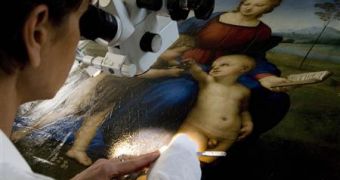Known by the original name of “Madonna del Cardellino”, Rafael's 107 by 77 cm (42 by 30 inches) painting is perhaps one of the masterpieces with the most violent past. But now it is safe and sound thanks to the joined efforts of a large number of technicians from the Opificio Delle Pietre Dure in Florence, one of Italy's most prominent art restoration laboratories. Painted in 1506 for the wedding of the wealthy wool seller Lorenzo Nasi, it depicts Virgin Mary with Jesus and John the Baptist as children.
Nasi's house crumbled in 1547 and broke the painting into 17 parts. It was later joined together with nails by a restoration artist of the time, Ridolfo di Ghirlandaio, who also painted over the ruptures to cover them. When it came into its possession, the Medici family financed some repairing attempts that would further hide the fractures. “We spent two whole years studying it before deciding whether to go ahead because with the damage it suffered in the past -- which was clearly visible in the x-rays -- a restoration attempt could go wrong,” shared Marco Ciatti, head of the laboratory's department of paintings.
Current interventions made use of microscopes, lasers, X-rays, reflective infra-red photography and CAT scans in a slow restoration process. Patrizia Riitano, chief of the restoration works for the painting, has closely monitored every small modification. She removed the results of the previous repairs, consisting of painting over the artist's original work, and using the latest technology, she painted inwards, keeping some time traces and minor artwork faults unaltered.
The overall endeavor involved more than 50 persons, including wood and photography experts. The larger binding nails were kept, but the smaller ones were removed. According to Riitano, “It was a very long process. We had to decide if to remove, what to remove, when to remove”. But the final result proves that the effort was worth its while, as the painting is now solid, the layer of dirt and grime removed and the colors are vivid once again.

 14 DAY TRIAL //
14 DAY TRIAL //